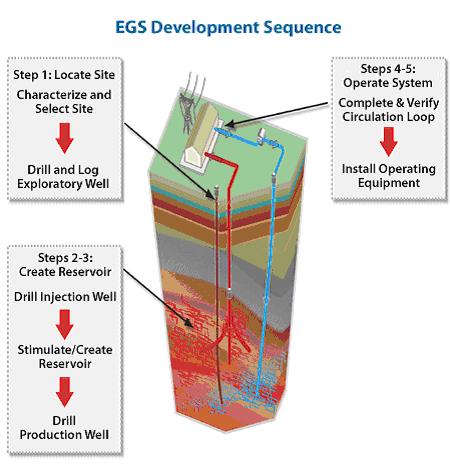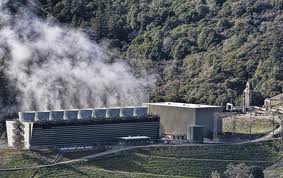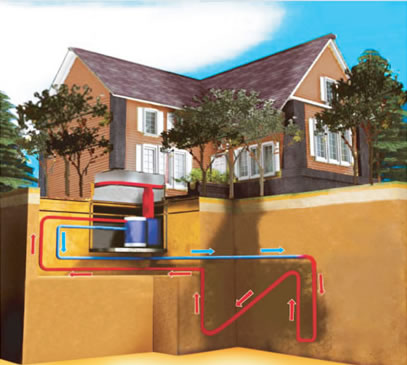The energy under our feet may prove to be the answer to producing a reliable 24 x 7 source of power for now and the future. Unlike wind and solar, geothermal energy is never interrupted. That’s because the Earth’s heat, whether in an area of active vulcanism or not, is ubiquitous. 99% of the planet is hotter than 1,000 degrees Celsius (1,832 Fahrenheit), and 99% of that last 1% is hotter than 100 degrees Celsius (212 Fahrenheit). Dig down every 100 meters (330 feet) and the temperature rises 3 degrees Celsius (5.4 Fahrenheit). Any water that percolates downward eventually turns hot. Drill a well, inject water into the underlying rock layers and harvest that heat to generate energy.

How reliable is geothermal energy?
- The first geothermal plant started up in 1904 in Larderello, Italy. It is still in use today.
- California began generating geothermal energy in 1960 in the mountains north of San Francisco. Today 15 power plants generate 725 Megawatts of electricity, enough power to light up and heat 725,000 homes (equivalent to all of San Francisco).

- Iceland, sitting on the Mid-Atlantic Ridge, generates 17% of its electricity and 87% of its heating requirements from geothermal.
- New Zealand gets 10% of its energy from geothermal power plants, the first which began operation in 1958.
- Other countries with geothermal power plants include Japan, Indonesia, Mexico, the Philippines, Kenya, Costa Rica and Nicaragua.
All of the above are utility-based geothermal power plants. There is another type of geothermal that exploits low-temperature sources, those where the heat source is 150 degrees Celsius (270 Fahrenheit) or less.
Low Temperature Geothermal
Geothermal power generated from low temperature sources has many uses. The heat can transferred to the surface to heat homes, buildings and greenhouses. Geothermal heat pumps can be used for heating and cooling by taking advantage of the constant temperature of the ground, 10 Celsius (50 Fahrenheit), just a few meters below the surface. The heat pumps recirculate antifreeze or air in buried pipes and cool down buildings in the summer and warm them in the winter. These can be passive or active systems. Passive systems use pipes that pass through a building or home and emit heat or cool the air. This is a low cost solution that would work well in the Developing World. Active systems use compressors and pumps to maximize heating and cooling.

For commercial applications of low temperature geothermal the heat can come from a variety of sources. These include:
- Heated waste water as part of an industrial process.
- Water injected into depleted oil wells and pumped back to the surface.
- Artesian sources that when pumped out are too hot for immediate human or animal consumption with the heat harvested as the water cools.
For power generation from low temperature geothermal conventional turbines are ineffective. But new technology is making it possible to generate electricity for commercial use with turbines that operate much like refrigerator compressors running backwards.
At Southern Methodist University in Texas, the Geothermal Laboratory is researching new technologies for generating energy from geothermal associated with oil and gas fields using waste water to power small binary electric turbines. The energy recovered from these installations is sold to utilities. The cost to produce the energy is much cheaper than comparable solar and wind installations.
In future postings to this blog site we’ll explore this subject even further, and will look at other natural sources being assessed by engineers and researchers to provide alternative heating, cooling and power here in the 21st century.








Great article!
In most locations, the temperature and quantity of readily available geothermal heat is so low that size and capital costs of “turbines/expanders” per unit of energy produced are uneconomically high. Competent energy engineers have been trying to make sense out of “anywhere” geothermal for about a century. Not many, if any, promising stones are yet unturned. “Anywhere” geothermal power will begin to make competitive economic sense when drilling companies can make a 12-inch diameter hole 25,000-feet deep for about a million dollars. That is to say we need about a 95% cost reduction in drilling the geothermal holes that would produce sufficient quantities of high quality steam to justify the costs of the surface equipment.
Perhaps if you can get a free exhausted oil well hole that’s 10,000 feet deep you can extract enough heat to run a 20-kW expander on a sustained basis. The market value of that amount of electricity is about a dollar per hour: $8700/year. But capital costs for the expanders, valves, heat exchangers, pumps, transformers, cables, etc. would likely exceed $200,000 per hole. If operating expenses were zero, the expanders and generators were immortal, there were no decline in heat production, and capital loan service costs were zero, it would only take 23-years to recover the initial investment. That’s why we see geothermal power plants only where very a lot of hot rock is near the surface, and even in those exceptional locations thermal efficiencies are only in the 10-20% range.
Geothermal comfort heating and cooling for homes costs less to install than swimming pools, and I would back government mandates requiring geothermal heating and cooling before granting swimming pool permits.
There’s a really good post about the larger potential of geothermal energy at http://physics.ucsd.edu/do-the-math/2012/01/warm-and-fuzzy-on-geothermal/
The conclusion is that it is a niche technology – useful in places, but there is not the capacity to provide a major solution – currently human global energy use is c.13TW but even utilising every bit of land area, geothermal could supply in the order of 2TW.
So useful, and worth exploiting the quick wins – niche technology works well in its niche. But will largely be a bit player.